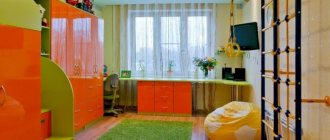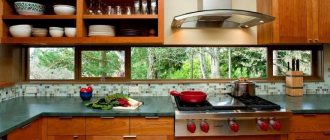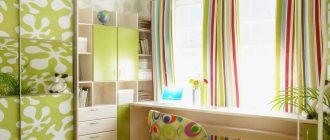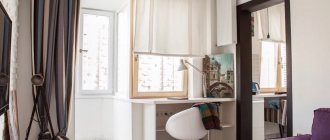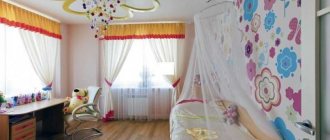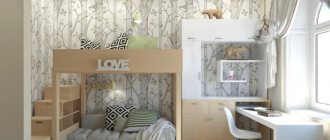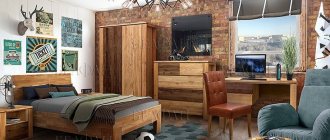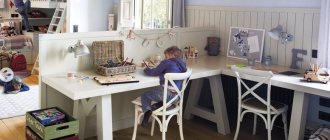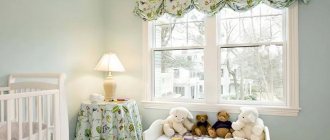Students of different ages have to complete different tasks at home. It will be convenient to prepare homework and do creative work if parents can properly organize a separate corner for it. The child’s academic performance, as well as his physical and emotional state, will depend on the correct arrangement of the workplace. Therefore, the home workplace must comply with existing standards and requirements. The schoolchildren’s corner will become the child’s full-fledged possession, where he can not only prepare homework, but also relax, engage in creativity and hobbies. Depending on the baby’s preferences, it is necessary to properly organize the work space. He should be comfortable here.
Choosing a place for your desktop
A schoolchild's desk should not be placed: In the kitchen. Even if it is roomy, it is not the best option. Firstly, the kitchen is a place not only for cooking, but also for constant gatherings, meetings, tea parties, clarifying problems and questions, etc. The child simply will not be able to concentrate on studying. Secondly, cuisine is food with which textbooks are completely incompatible. At the door. We reject this option immediately. You can’t do homework either at the door or with your back to the door. This arrangement provides psychological discomfort for the child. Under the 2-tier bed. Of course, you will be able to partially save square meters, but the child is guaranteed discomfort. Psychologists do not even recommend sleeping on the lower tiers - “pressure” from above does not bring any benefit. And it will also be difficult to help a child with his homework - there will be even less space for an adult. In the center of the room against the wall. This is a great option for mom and dad. You can immediately see what the child is doing. But for the baby himself, the option is not particularly attractive. Just like an adult, a child is much more comfortable in a private corner, where there is no need to hide notebooks from prying eyes.
When organizing a workplace for a schoolchild, parents should take into account several factors. If possible, try to give your study space some privacy. Of course, it is best to provide a separate room for the child, but for many families this is a luxury.
When creating a study space for a schoolchild at home, take into account not only the technical characteristics of the furniture, but also the recommendations of psychologists. The ideal option is when there is a wall behind your back. Provide your child with the opportunity to control the room where he prepares his homework. If someone opens the door, the student should not look back to see him. It’s good if he can look at the person entering simply by turning his head. A good option is to be located near a window. But only when the student’s desk is set a little away from him. This will prevent glare on the computer screen and prevent sunlight from blinding your child.
Natural light in the study room is a must. However, keep some things in mind. If the child is right-handed, set the table so that the light falls on the tabletop to the left. For a left-handed person, the opposite is true.
Of course, it is not always possible to follow all the recommendations, but there are rules that must be taken into account:
- A little privacy. We create it either with the help of furniture or through a separate room. You can fence off the table with a bookcase, install it on an insulated loggia, set aside a separate cozy place in the bedroom, etc.;
- Daylighting is a must! Is the child right-handed? This means the light should come from the left. And if you're left-handed, it's the other way around.
- The TV should be located as far away from the workspace as possible. Minimum 2 meters is a safe distance from television radiation.
- If necessary, you can even place a study table in the common room. In this case, you will have to resort to dividing the room into zones. For this you can use screens, shelves, podiums, etc.
If you really don't have enough space:
- The table can be made folding (from the wall), but, again, taking into account the possibility of privacy.
- If there are two children, then you can connect their tables with one partition (or a bookcase for textbooks) - both space saving and privacy.
- You can build a table on a long tabletop, designer stretched along the wall above the cabinets. Part of the table top is for household items, part is for the child personally.
- Extended window sill. In tiny apartments this option is often used. The window sill is widened, lengthened, and a high comfortable chair is placed.
- Small corner table. Convenient in small spaces. Additional shelves wouldn't hurt.
- If you have some imagination, the table can be installed anywhere in the common room using space zoning (color, podium, screen, etc.). Zoning the space of a children's room for children of different sexes is an excellent design and convenience.
- Table transformer. This is also a good option, allowing you to expand the work surface and change the height of the legs according to the need.
Territory in half
The main difficulty in designing a nursery for children of different sexes is not to offend anyone. Therefore, think about how to delimit the territory for two
Having your own space is especially important at a young age. After all, it is at this time that the perception of the outside world is formed and relationships with it are built.
Parallel zoning
An excellent scheme for spacious, and best of all, square rooms. Although you can think of an elongated room: you just need to experiment with the layout and location of windows and doors.
The room is simply divided in half. To do this, use a closet, rack, partition, curtains. The color scheme of both parts may differ. To prevent the nursery from looking too tacky, leave the general style, background or accents. For example, plain walls or beds of the same model, but with different colored textiles.
Diagonal zoning
Diagonal zoning differs from parallel zoning only in the location of the partition. This scheme is suitable for rooms with two windows on adjacent walls.
Diagonal division of the nursery is convenient to use in private houses or corner apartments.
Common areas
This division involves two separate sleeping places and common areas for games. This is convenient for small children of different sexes of about the same age. They happily play together, and cribs are enough for them to have privacy.
But when children grow up, problems may begin. You will need at least two separate workstations and two storage spaces.
The right furniture for a schoolchild
Comfortable table
The key element of the office is a good, comfortable table. This rule also works for children. Constructors and furniture designers list many requirements for a child’s desk. Its main task is to provide the student with comfort.
The correct table height is determined as follows: the child, placing his elbows on the tabletop, should touch his temples with his fingers. With low furniture, the student will lean too much and as a result, problems with posture will appear. Excessive height will force the child to stretch out, which will lead to premature fatigue and dissipation of attention.
In addition, the width of the tabletop also matters. You will place the computer on it, and the recommended distance from the monitor to the eyes is 60–70 cm. Pay attention to corner tables, where the computer and work areas are separated.
The child’s posture is determined not only by the height of the table, the comfort of the chair, but also by the inclination of the tabletop. If you wish, you can remember desks with a slight slope. This design reduces the load on the spine and provides proper lighting when writing and reading. A good option is a table with an adjustable table top.
It is better to choose wood as a material. It is necessary to ensure that there are no defects, various cracks, untreated parts, or glue residues on the table. If the furniture has an unpleasant smell, then this model should be left in the store.
It is also worth considering gender differences when choosing a table. Boys need more space than girls. Based on this, your daughter can buy a more compact table model, and your son can buy a model with a spacious tabletop.
Size table: For a height of 100-115 cm: table height - 46 cm, chair - 26 cm. For a height of 115-130 cm: table height - 52 cm, chair - 30 cm. For a height of 130 - 145 cm: table height - 58 cm, chair - 34 cm. With a height of 145 - 160 cm: table height - 64 cm, chair - 38 cm. With a height of 160 - 175 cm: table height - 70 cm, chair - 42 cm. With a height of more than 175 cm: height table - 76 cm, chair height - 46 cm.
Table shape
There are various types of furniture for schoolchildren on sale today. The table can be straight or angular. The choice depends on the dimensions of the room, as well as the creative preferences of the child. The simplest table is considered to be rectangular in shape. If you do not intend to place a computer on it, the size of the tabletop may be small. However, a sufficient number of cabinets and shelves should be provided.
Comfortable chair
When working, the edge of the table should be at the level of the child’s solar plexus. But children, as you know, grow up. The annual purchase of tables of the required height, although uncritical, takes a toll on the family budget. It is best to buy a good anatomical chair with adjustable height.
Of course, you don’t need to buy the first chair you come across that says “anatomical,” but the one that was created specifically for children. Buying such furniture is not difficult, you need to know a few recommendations that are easy to remember:
- The seat height and backrest angle should be adjustable. Today this is not a problem;
- You need to determine the height of the chair. The ideal option is when the legs of a child sitting on a chair are bent at an angle of 90°. An acute angle and high raised knees – the height is insufficient, an obtuse angle – excessive;
- Do not confuse furniture for schoolchildren with office and playroom furniture. Neither a wheelchair nor a cheerful chair from a nursery will suit a child. Furniture for classes is called school furniture; when purchasing it, they are guided by the weight of the student. As a rule, the average value varies from 40 to 50 kg;
- The general requirement for all furniture is safety. We are talking not only about the reliability of the design, but also about the materials used in its manufacture. The easiest way to make sure that furnishings will not harm your child is to request a quality certificate.
- The seat should be comfortable and soft. If it's a chair, use a thin pillow.
- The materials are environmentally friendly. Check the quality certificate!
- A flat and firm back, against which the child’s back should be pressed tightly (this takes the load off the spine).
Types of chairs
Classical. This type of furniture is distinguished by a flat seating surface and a backrest that follows the natural curve.
It is inexpensive and eliminates asymmetry in the shoulder girdle.
Movable chair. This furniture has only one fulcrum.
The chair has no back and forces the back muscles to constantly work.
With support on your knees. A chair with knee support helps relieve stress on the spine.
It directs most of the load to the legs and buttocks.
With the ability to adjust the back and armrests. This option is more popular among parents.
This chair is easier to customize to the child’s individual parameters.
Additional furniture
It is very important for a student to properly organize the space around him. If there are a lot of unnecessary things nearby, piled up in large piles, this will not promote concentration. The student's attention will wander. The student's workplace at home should have additional furniture. These can be various bedside tables, wall cabinets, shelves or bookcases. It all depends on the style of the interior, as well as the free space in the room. Textbooks, notebooks, and office supplies should be at hand. The student should have easy access to them. Therefore, it is necessary to install all additional furniture elements so that the child can simply reach the cabinet or shelf. Cabinets should not be hung high. Due to inconvenient access to their things, the child will feel discomfort. His workplace will evoke negative associations.
Storage systems
Many factors influence productivity, and a tidy desk is one of them. It is important to properly organize storage systems: put pencils in special glasses, place books on additional shelves, put notebooks in niches and drawers. It is also good to use magnetic, cork, and slate boards, on which it is convenient to leave important notes and attach notes. Children often forget something, so such an item will teach him to self-organize.
What curtains to choose in a nursery with a table by the window to make it beautiful and comfortable?
The comfort of sitting at a table opposite a window is determined by a number of factors. Too bright light and heat from the sun's rays can create completely unbearable working conditions. Therefore, you need to carefully consider protection from excessive sunlight. And also plan to install additional artificial light sources.
The optimal solution would be to equip the windows in the children's room with a table-window sill with roller blinds or blinds. Different angles of inclination of the slats, lowering and raising the canvas will help you choose the optimal lighting.
Most blinds have a laconic design that can be harmoniously complemented with curtains to suit your taste. Light curtains with a length just above the level of the work surface look best.
Curtains in a nursery with a table by the window can be made longer by adding special garters. Asymmetry in the design of a window opening and curtains with bright prints will also help make the interior design of a children's room cheerful and interesting.
Study area lighting
Myopia is the scourge of modern youth. If we look at the statistics, it turns out that 37% of university students suffer from myopia. On average across the country, every fourth Russian experiences vision problems. Oculists and ophthalmologists conduct a lot of research on the dangers of computers, televisions, etc. But they all confirm one rule - you need to take care of your eyesight from childhood. And this is impossible without proper lighting of the student’s workplace.
It is recommended that the student’s workplace be located near the window. First of all, this allows the child to work in good natural light. Secondly, the baby can take a break from lessons and look at the sky, birds and trees. This has a beneficial effect on the student’s mood and allows him to exercise the eye muscles, which are tense while doing homework.
The presence of daylight is a prerequisite for a child’s workplace. But besides this, of course, you need a personal lamp - bright, safe, comfortable. They usually place it on the table on the left if the child is right-handed (and vice versa).
How to choose a lamp?
Main criteria:
- The light should be as close to natural as possible. We choose a lamp with yellow light - an incandescent lamp of 60-80 watts. Don’t skimp on your child’s vision—energy-saving white light bulbs won’t do! Halogen light bulbs are too bright for a baby - they are not worth purchasing.
- Luminescent ones are also not an option - their invisible flicker tires the eyesight.
- In addition to your own lamp, of course, there must also be general lighting in the room, otherwise the child’s vision will deteriorate very quickly. This could be a chandelier, sconce, or additional lamps.
- Design of a child's table lamp. Basic requirements: minimum elements. The child should not have the desire to disassemble the lamp or play with it. Therefore, lamps in the form of toys are not suitable for first-graders. Various decorative elements in the form of crystal, etc. are also undesirable. They create glare, which negatively affects vision.
- Safety. The lamp must be shockproof. So that the child, while playing, does not accidentally break it and get hurt.
- The lamp must have a lampshade (preferably yellow or green) so that the light does not blind the child.
- It is desirable that the design of the lamp allows you to change the angle of its inclination, and that the base of the lamp is carefully secured to the table using a bracket.
Thematic design ideas for a boy's room
It is better to choose the design of a boy’s room together with him. If he is still small, you can offer him a choice from several options.
Teenagers should be allowed to come up with their own ideas and discuss them. It’s good if the interior reflects his interests and hobbies, even if they are not among the most traditional “boyish” topics - for example, ornithology or classical music.
The more the environment matches the child’s personality, the more comfortable he will feel.
Comics and superheroes
Superhero themes are now popular not only among children. However, the world of comics is by no means limited to it.
You can find photo wallpapers with superheroes on sale, but for a child’s room it is better to choose decorative elements that are easier to replace and move: figurines, toys, posters, attributes such as gloves and other costume elements.
Space theme
Books, movies and gaming products on this topic are endlessly varied, which makes it easier to select decorative items to suit a boy’s taste. These can be lighting fixtures in the shape of planets, photo wallpapers with cosmic landscapes, textile prints with motifs from your favorite game universes.
Auto and other equipment
This is also a popular theme for decorating a boy’s room. However, often solutions of this kind (beds in the shape of cars, too cartoony decor, etc.) look too infantile. Soon after the boy goes to school, this design will cease to be relevant.
Colors in the interior
Psychologists and designers agree that it is necessary to choose neutral color schemes for a student’s workplace. You can use white or beige as the background, and choose furniture or accessories in brighter and more interesting shades. There should not be a lot of colored elements so as not to distract the child from doing homework. Brown and yellow colors are able to focus attention and stimulate brain activity, so they are recommended to be used as accent colors.
Green color in the interior
When designing a workplace at home, you need to pay attention to the color scheme. Green shades are considered one of the best options. There shouldn't be too many of them, but as a complement to a neutral base, this color is perfect. Green shades are considered the most familiar to the human eye. They relax the psyche, setting you up for calm. This is a breath of energy that allows you to tune in to work. If the work corner is completely decorated with this color, the student will not be able to get ready for work. Therefore, green shades are combined with light beige and brown colors of furniture and accessories. A few splashes of red will liven up such an interior. In this case, it is allowed to use any light shades of green. They may approach blue or yellow.
Yellow shades of the interior
According to doctors, yellow is one of the preferred colors when decorating an indoor work area. However, it should not be used in its pure form. It is better if bright yellow colors are present in accessories. These shades tone, stimulating human intellectual activity. Therefore, when decorating a workplace at home, yellow shades should be considered as one of the best options. Walls and ceilings should not be painted this color. Yellow accessories or furniture would be preferable. This is a light, warm color. However, the child must first like it.
What else is worth paying attention to?
When setting up a study corner, do not forget about the immediate future. Children grow quickly, so give preference to furniture that can be resized. Otherwise, you will have to initially rely on standard furniture or change the furnishings in the child’s room every year. In the first case, you risk his health, in the second, your finances.
When choosing furniture for a children's workplace, pay attention to useful little things: magnetic boards, additional shelves and special containers. Unlike ordinary boxes, they are always at hand. When a child is of preschool or primary school age, it is recommended to store important things in a visible place. Otherwise he may forget about them. An excellent option is transparent modules or containers attached to the desktop area.
Creative accessories
Instead of ordinary scissors or paper clips, you can choose accessories of unusual shapes or shades. Your child will be pleased to put pencils in an organizer in the shape of a funny hedgehog. And it is much more interesting to fasten sheets of the next abstract with multi-colored strong ones than with ordinary gray ones. This will teach the baby to have order, and will also instill in him a love for school.
